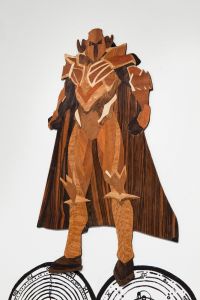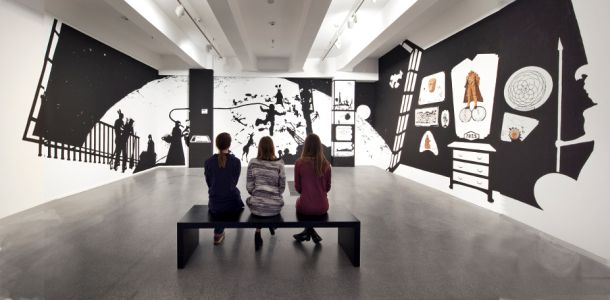Das mechanische Corps /
The Mechanical Corps
Kuratiert von
Peter Lang und Christoph Tannert
Auf den Spuren von Jules Verne
On the trail of Jules Verne

| HMKV Dortmund Das mechanische Corps / The Mechanical Corps Kuratiert von Peter Lang und Christoph Tannert Auf den Spuren von Jules Verne On the trail of Jules Verne |
Bilder unten. Click to enlarge. |
| Die Ausstellung bezieht sich auf eine umfassende kulturelle Tendenz.
Am Beginn des 21. Jahrhunderts mit einer extremen Beschleunigung und Erweiterung
der Informationsdichte und globalen Kommunikation, zeigt sich in den bildenden
Künsten, in Mode und Design, in Literatur und Film, in Comic und
Pop ein ästhetischer Rückgriff auf die Welt des ausgehenden
19. Jahrhunderts. Allenthalben entdeckt man Verweise auf die Welt Jules
Vernes. Dieses in die Vergangenheit verweisende Element stellt ein Paradoxon
dar. Auf der einen Seite miniaturisiert sich die technische Welt und Nanowissenschaften
und autonome Maschinen werden immer sicherer als zukünftige dominante
Entwicklungen betrachtet. Auf der anderen Seite schlüpfen Protagonisten
wie die Steam-Punks in nostalgische Hüllen und Künstler bauen
mit großem Aufwand schwere mechanische Geräte in Handarbeit.
Einer der bekanntesten Modeschöpfer, Marc Jacobs, lässt bei
der Pariser Fashionshow 2012 einen Dampfzug wie 1890 einfahren und der
neuste Science-Fiction-Film "Prometheus - Dunkle Zeichen" (Regie:
Ridley Scott) verwendet ein äußeres Raumschiffdesign, das an
das genietete U-Boot Kapitän Nemos erinnert. Mit der Ausstellung wollen die Kuratoren Peter Lang und Christoph Tannert dieses Paradoxon der zivilisatorischen Entwicklung kritisch untersuchen. Was führt zu dieser Entwicklung, was steht dahinter? Dabei beziehen sie sich auf Bereiche der Hochkultur als auch der Massen- und Fan-Kultur bis hin zur Mode. Bekannte KünstlerInnen stehen neben Art-Brut-Künstlern und den Werken junger Nerds. Die Begeisterung für das Mechanische ist ungebrochen. Und wenn der Film "Die Reise zum Mond" des französischen Filmpioniers Georges Méliès aus dem Jahr 1902 gerade eine Rekonstruktion und begeisternde Neuaufführung erfährt, verstärkt das den gesamten Drift heutiger avantgardistischer Bewegungen ins scheinbar langsamere Gestern. Was sagt uns das über unsere gesellschaftliche Entwicklung? Wohin gehen die zivilisatorischen Abenteuer? |
At the beginning of the 21st century with its extreme
acceleration and increasing concentration of information and global communication,
aesthetic recourse to the world of the late 19th century is emerging in
fine art, fashion and design, and films and comics. At the same time,
the technical world is being miniaturised as nanoscience, and autonomous
machines are regarded with ever growing certainty as a development that
will dominate the future. A paradox of civilizing development emerges,
which the curators Peter Lang and Christoph Tannert are questioning through
art as well as non-art in the project THE MECHANICAL CORPS.
What is the source of this fascination with the
aesthetics of old machines, with the simplicity and – seen from
today’s perspective – slowness symbolised in this way? What
is expressed by a contemporary world view seeking the stuff of dreams
and the incredible? The exhibition breaks through the apparent liberalism of the art system and links the disparate – elements of High and Low, classical and popular culture, art and kitsch. Works of fine art are combined with works by outsiders: industrial objects, craftwork, fashion, design, comics and films. Value systems, time levels and media are mixed in the hope of offering the public added reflection and improved insights. |
 Foto by Hannes Woidich |
 ARES Intarsie/wood inlay |
||